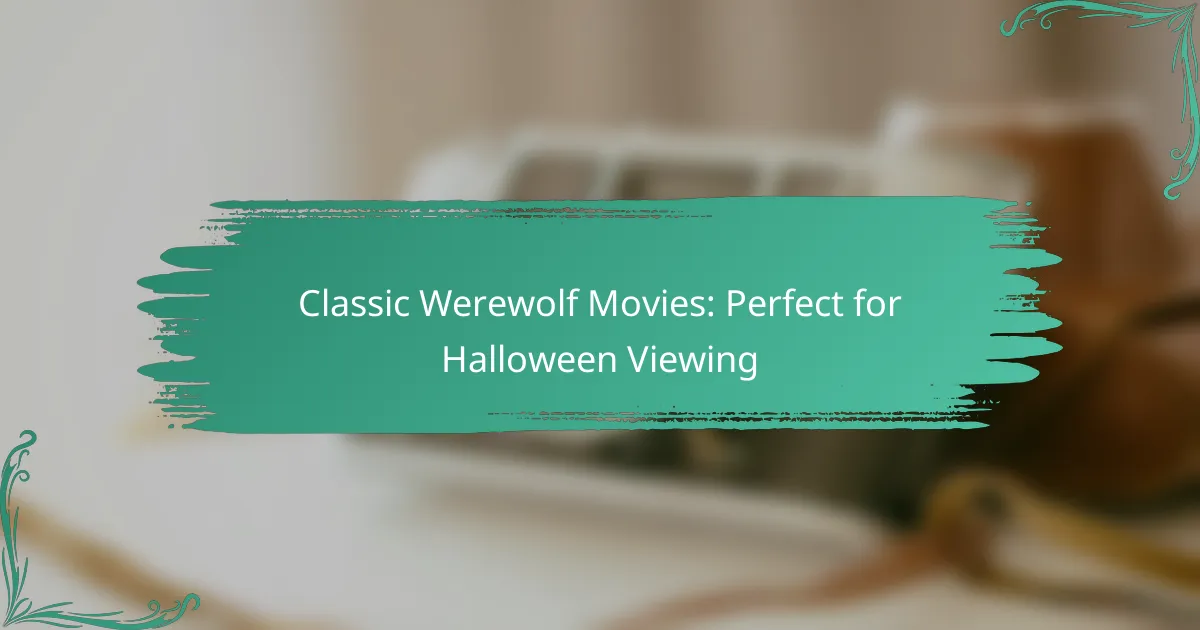As Halloween approaches, classic werewolf movies offer a thrilling blend of horror and folklore that captivates audiences. These iconic films not only showcase the terror of transformation but also evoke the primal fears that resonate deeply during the spooky season. Perfect for a chilling movie night, they combine suspense with a touch of dark humor, making them a must-watch for any Halloween celebration.
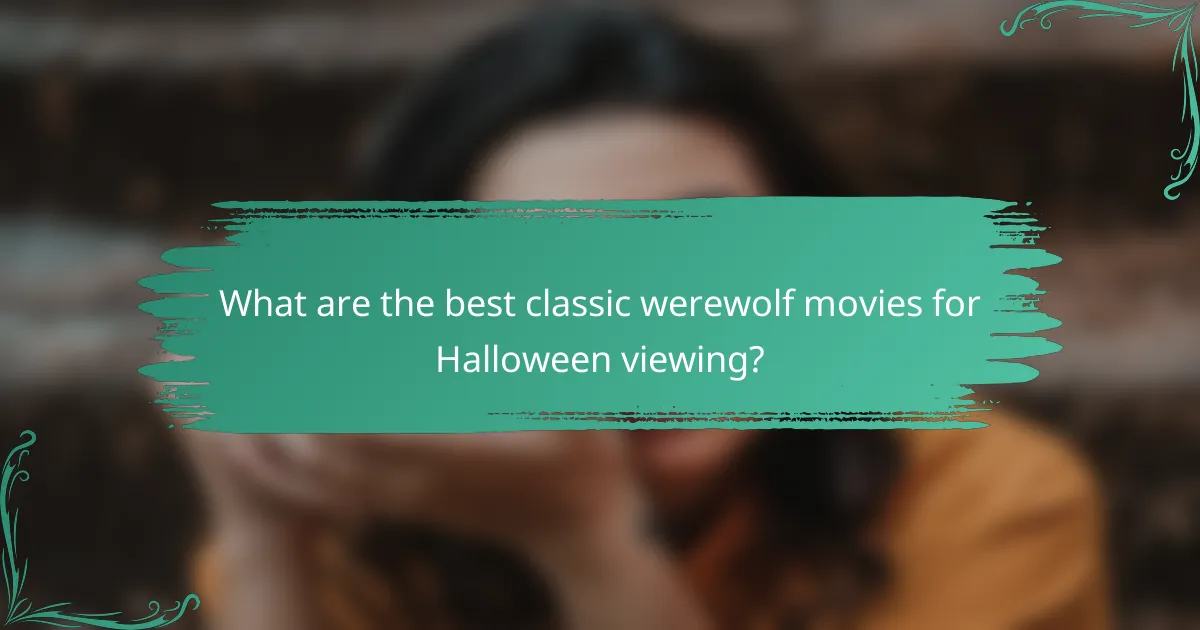
What are the best classic werewolf movies for Halloween viewing?
Some of the best classic werewolf movies for Halloween viewing include iconic titles that have shaped the genre. These films combine horror, folklore, and often a touch of dark humor, making them perfect for a spooky night in.
The Wolf Man (1941)
The Wolf Man is a seminal classic that set the standard for werewolf films. Starring Lon Chaney Jr., it tells the story of Larry Talbot, who transforms into a wolf-like creature after being bitten by one. The film’s atmospheric setting and memorable makeup effects have made it a Halloween staple.
Key elements include its exploration of duality and the tragic nature of the werewolf curse. The film’s iconic transformation scene remains influential in horror cinema.
An American Werewolf in London (1981)
An American Werewolf in London blends horror with dark comedy, following two American backpackers who encounter a werewolf in England. The film is renowned for its groundbreaking special effects, particularly the transformation sequence, which won an Academy Award.
This film explores themes of friendship and the consequences of fate, making it both entertaining and thought-provoking. Its unique mix of humor and horror makes it a must-watch for Halloween.
Dog Soldiers (2002)
Dog Soldiers offers a fresh take on the werewolf genre by placing soldiers in a survival scenario against a pack of werewolves. Set in the Scottish Highlands, the film combines military action with horror, creating a tense atmosphere.
The practical effects and strong character development elevate the film, making it a favorite among horror enthusiasts. Its blend of action and terror is perfect for those looking for an adrenaline rush this Halloween.
Ginger Snaps (2000)
Ginger Snaps is a unique werewolf film that uses the transformation as a metaphor for adolescence and female empowerment. The story revolves around two sisters, with one undergoing a dramatic change after being bitten by a werewolf.
This film stands out for its strong female characters and social commentary, making it more than just a horror flick. Its blend of horror and dark humor resonates well with viewers looking for something different during Halloween.
Werewolf of London (1935)
Werewolf of London is one of the earliest werewolf films, featuring a botanist who becomes a werewolf after being bitten in Tibet. The film is notable for its atmospheric storytelling and early special effects.
While it may not have the same level of recognition as later films, its historical significance in the genre makes it an interesting watch for classic horror fans. Its influence can be seen in many subsequent werewolf films, solidifying its place in Halloween viewing traditions.
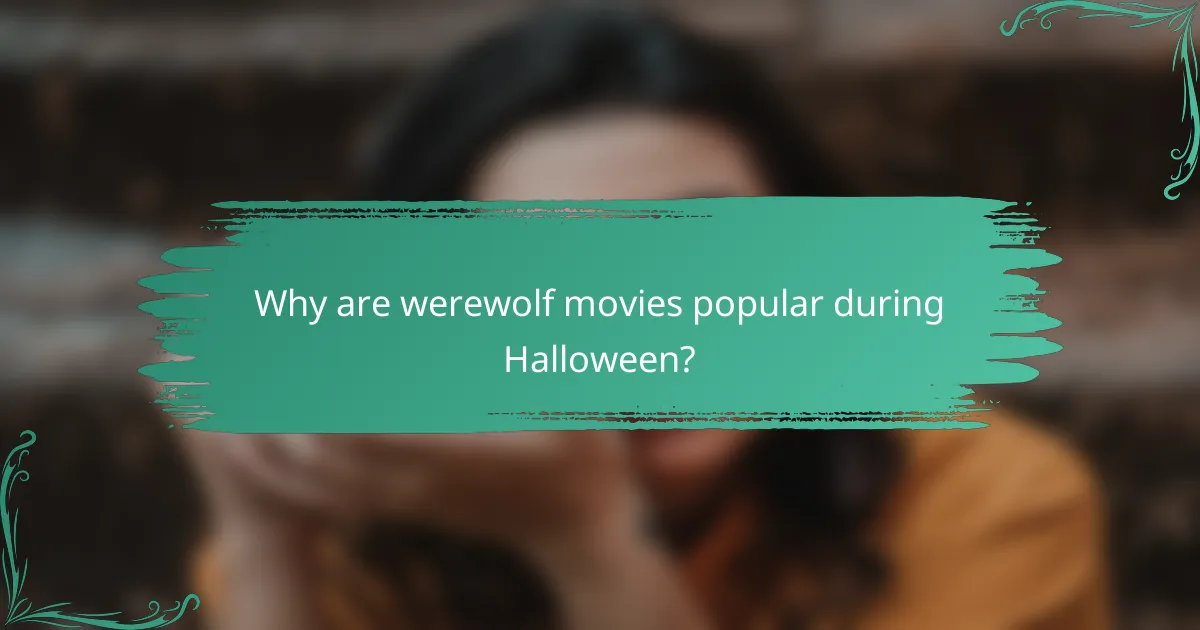
Why are werewolf movies popular during Halloween?
Werewolf movies are popular during Halloween due to their deep roots in folklore and their ability to evoke primal fears. The themes of transformation and the supernatural resonate strongly with the Halloween spirit, making these films a staple for the season.
Connection to folklore and mythology
Werewolves have been part of folklore and mythology across various cultures for centuries. Legends often depict them as humans cursed to transform into wolves, symbolizing the struggle between civilization and primal instincts. This connection to ancient tales adds a layer of depth to werewolf films, enhancing their appeal during Halloween.
Many stories, such as those from European traditions, highlight the fear of the unknown and the consequences of losing control. This cultural significance makes werewolf movies resonate with audiences seeking a connection to age-old fears during the Halloween season.
Symbolism of transformation
The transformation from human to werewolf symbolizes the duality of human nature, representing both our civilized selves and our more savage instincts. This theme of metamorphosis is particularly compelling during Halloween, a time when people explore their darker sides. In films, this transformation often serves as a metaphor for personal struggles or societal issues.
Viewers are drawn to the idea of change, whether it’s a physical transformation or an emotional journey. This symbolism allows audiences to reflect on their own identities and fears, making werewolf movies a thought-provoking choice for Halloween viewing.
Thrilling horror experience
Werewolf movies deliver a unique blend of horror and suspense that captivates audiences. The tension of the hunt, the fear of the unknown, and the visceral imagery of transformation create an exhilarating experience. Many films utilize jump scares and atmospheric settings to heighten the sense of dread, making them perfect for Halloween nights.
Additionally, the unpredictability of werewolves adds to the thrill. Unlike traditional monsters, werewolves can be anyone, which fosters a sense of paranoia and fear among characters and viewers alike. This element of surprise keeps audiences engaged and on the edge of their seats, solidifying the werewolf genre’s place in Halloween traditions.
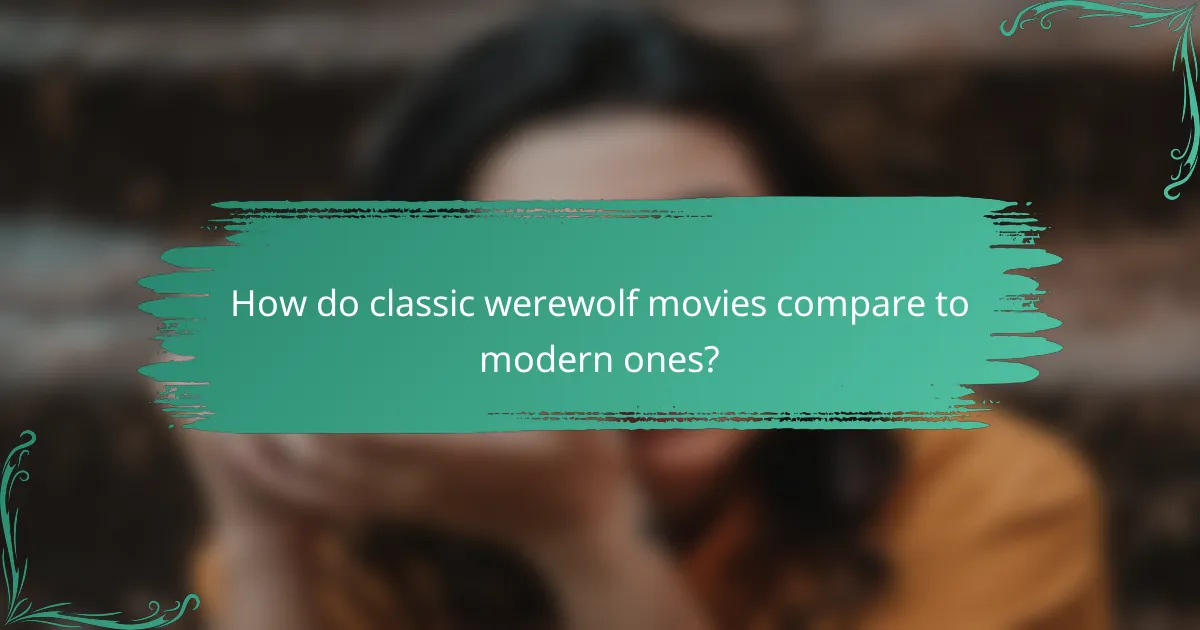
How do classic werewolf movies compare to modern ones?
Classic werewolf movies often emphasize practical effects and atmospheric storytelling, while modern films frequently rely on CGI and complex narratives. This difference shapes viewer experiences, with classic films focusing on suspense and character development, whereas contemporary films may prioritize visual spectacle and rapid pacing.
Practical effects vs. CGI
Classic werewolf movies typically utilized practical effects, such as makeup and animatronics, to create realistic transformations and creatures. This hands-on approach often resulted in a tangible sense of horror that many viewers find more immersive. In contrast, modern films frequently employ CGI, which can enhance visual effects but sometimes lacks the raw authenticity that practical effects provide.
Storytelling styles
The storytelling in classic werewolf films often revolves around character-driven plots, exploring themes of humanity, fear, and isolation. These narratives tend to build tension gradually, allowing viewers to connect with the characters’ struggles. Modern werewolf movies, however, may incorporate faster-paced storytelling and complex plots, sometimes sacrificing character depth for action and special effects.
Cultural impact
Classic werewolf movies have significantly influenced the horror genre, establishing archetypes and tropes that continue to resonate today. Films like “The Wolf Man” have shaped public perceptions of werewolves, embedding them in popular culture. Modern werewolf films often reference these classics, but they also reflect contemporary societal fears and issues, adapting the werewolf mythos to resonate with current audiences.

What themes are common in classic werewolf films?
Classic werewolf films often explore themes such as identity, isolation, and the conflict between nature and nurture. These themes resonate deeply with audiences, reflecting human fears and societal issues through the lens of transformation and monstrosity.
Identity and duality
Identity and duality are central themes in werewolf films, showcasing the struggle between human nature and the beast within. Characters often grapple with their dual identities, leading to internal conflict and moral dilemmas. This theme highlights the fear of losing control and the quest for self-understanding.
For example, in “The Wolf Man,” Larry Talbot’s transformation into a werewolf symbolizes his battle with his darker impulses. This duality can serve as a metaphor for real-life issues, such as addiction or mental health struggles, making the theme relatable to viewers.
Isolation and fear
Isolation and fear are prevalent in classic werewolf films, emphasizing the loneliness that often accompanies transformation. Characters frequently find themselves alienated from society, either due to their condition or the fear it instills in others. This theme underscores the psychological impact of being different and the societal rejection that can follow.
In “An American Werewolf in London,” the protagonist’s isolation intensifies his fear and confusion as he navigates his new reality. The film illustrates how fear can lead to further isolation, creating a vicious cycle that amplifies the horror of the werewolf experience.
Nature vs. nurture
The nature vs. nurture debate is a significant theme in werewolf films, questioning whether one’s monstrous behavior is inherent or shaped by external factors. This theme invites viewers to consider how environment and upbringing influence identity and morality. It raises questions about free will and the extent to which individuals can control their darker instincts.
In “Ginger Snaps,” the transformation of the main character into a werewolf serves as a metaphor for the challenges of adolescence and the influence of societal expectations. The film explores how external pressures can trigger latent instincts, blurring the lines between nature and nurture in the context of monstrous behavior.

What viewing criteria should I consider for werewolf movies?
When selecting werewolf movies for viewing, consider the audience age rating, the film’s style and era, and the director’s vision. These factors will help you choose films that align with your preferences and the atmosphere you want to create for Halloween.
Audience age rating
The audience age rating is crucial as it indicates the film’s suitability for different viewers. Werewolf movies can range from family-friendly to highly graphic, so check ratings like PG-13 for moderate horror or R for more intense content.
For family viewing, consider films rated PG or PG-13, which often focus on suspense rather than gore. Examples include “The Wolfman” (2010) or “Teen Wolf” (1985), which are entertaining without excessive violence.
Film style and era
The style and era of a werewolf film significantly influence its tone and storytelling approach. Classic werewolf movies from the 1930s to the 1950s, like “The Wolf Man” (1941), often emphasize suspense and atmosphere, while modern films may incorporate advanced special effects and a faster pace.
Consider whether you prefer the vintage charm of black-and-white films or the contemporary thrill of CGI effects. Films like “An American Werewolf in London” (1981) blend humor with horror, showcasing a unique style that appeals to a broad audience.
Director’s vision
The director’s vision shapes the narrative and emotional impact of a werewolf movie. Different directors bring varied interpretations to the werewolf mythos, affecting how the story unfolds and resonates with viewers.
For example, directors like John Landis in “An American Werewolf in London” focus on blending horror with comedy, while others may take a more serious approach, as seen in “The Howling” (1981). Understanding a director’s style can help you select films that match your viewing preferences.
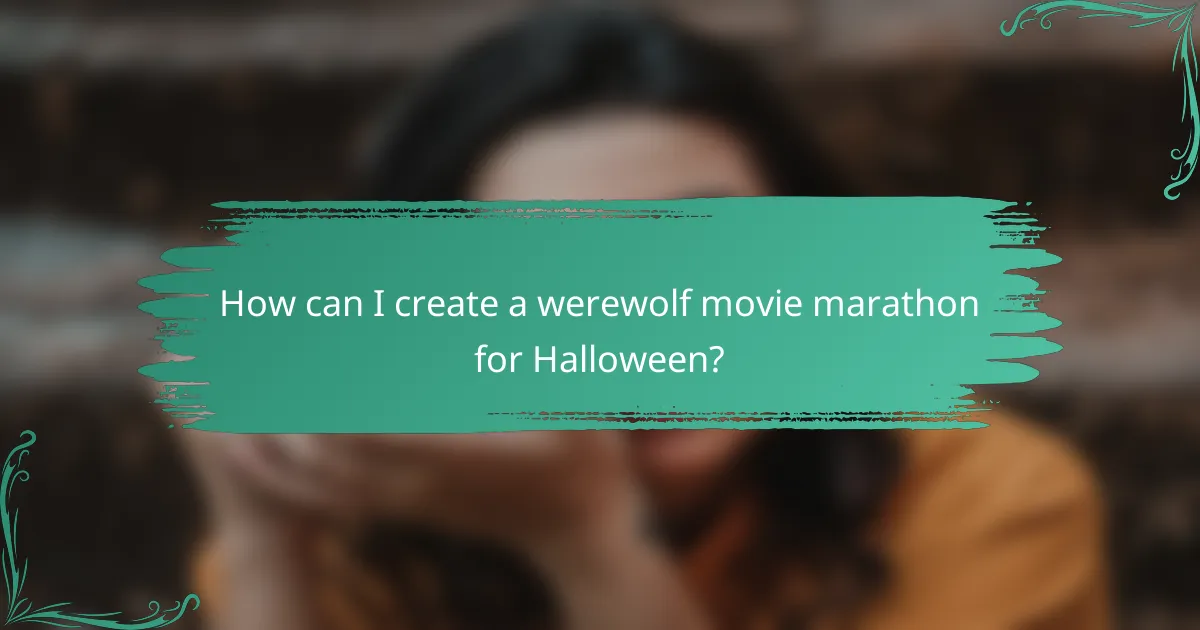
How can I create a werewolf movie marathon for Halloween?
To create an engaging werewolf movie marathon for Halloween, start by selecting a variety of films that showcase different interpretations of werewolf lore. Aim for a mix of classic and contemporary titles to appeal to all viewers.
Curate a themed list
Begin by compiling a list of werewolf movies that span various styles and eras. Consider including classics like “The Wolf Man” and “An American Werewolf in London,” alongside modern takes such as “Dog Soldiers” and “The Howling.” This variety will keep the marathon fresh and interesting.
When curating your list, think about the mood you want to set. For a more comedic tone, include films like “Teen Wolf” or “WolfCop.” If you prefer horror, focus on darker titles. Aim for around five to ten films to create a manageable viewing schedule.
Finally, consider the runtime of each movie to ensure your marathon fits within a reasonable time frame. A typical movie runs about 90 to 120 minutes, so plan breaks between films for snacks and discussions to enhance the experience.
